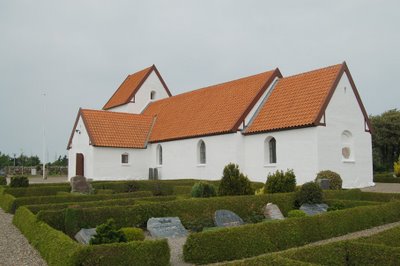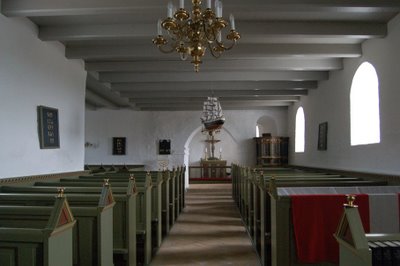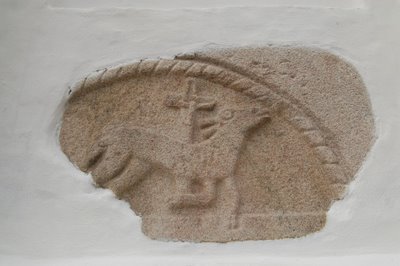
Lild Church

Interior

Baptismal font older than the church.

Fine church ship

God's Lamb
Lild Church is in its present look probably the youngest in the district. It has a late Gothic choir and nave, a tower to the west and a porch to the south plus an extension from ab. 1840 to the north. The low building is in its whole probably built in the late Gothic period, likely after 1460. The walls are mostly in raw field stones, although with some monk bricks in the upper sections. From original details are only the south door in a point arched frame and the bricked-up flat round-arched north door.
The inside of the church has beamed ceilings, the choir arch is vaguely curved with simple brick-profiles in the frame stones. The small tower is contemporary with or only a little younger than the nave and in the same materials. It has a pointed tower arch and an octagonal cross vault in the bottom room. The gables are pretty new and the tower was possibly higher than it is now. The porch is also late Gothic but without preserved details except two small flat curved holes in the walls. A cross arm on the north side of the nave is of the same character as the extension at Klim Church from 1847. A Romanesque thympanum with a cross-bearing lamb is bricked-up in the east window of the church and origins from Tømmerby Church. The building was renovated in 1938.
The whole church room was decorated with late Gothic frescoes, which an examination in 1939 showed to be so badly kept that a restoration was impossible. From the original communion table is kept a plate and as an altar decoration is a carved wooden crucifix from ab. 1942 by Axel Poulsen. A simple granite font, medieval, but of indefinable age. A pulpit from the end of the 1500s of the same type as in Gøttrup church. Church bells 1) 1674 by Arent Kleiman in Lübeck 2) cast 1920 by Smith's Støberier in Aalborg for Haderslev Vor Frue.

Bulbjerg Klint
Bulbjergknuden lifts high above the low Stone Age sea land and end out to the sea in a 40 m high steep Bulbjerg Klint (1503 Bwlbierig, 1625 Bulbjerg Klint). It consists of limestone (bryozokalk) from the Cretaceous Period (danium-period) with flat curved strokes of flint. In about 100 m distance out into the sea was the strange pillar Skarreklit, also limestone and flint, which some years ago lifted 15 m above sea level, but it has now eroded to be just a small stone above the water.
Names in the Middle Ages and the 1600s:
Lild (1363 Lyllæ kyrky, * 1430 Lille sogen, * 1438 Lillekiercke sogen);
Lund (* 1447 Lundt, 1471 Lundh); Bjerget (* 1504 Biere, 1552 Biergit); Kæret ( * 1553 Wester Kier, 1610 Paa Kierett); Nørklit (1552 Nørre Clitt); Koldkær (1483 Kolkeer); Rotbøl (1470 Rotbøøll); Myrup (1483 Meyrup, 1552 Myrrup); Holegård (1573 Holle, 1664 Huoull); Rolsgaard (1483 Rolszgaardt); Vabesgård (* 1438 Wathbeck, 1664 Wabech).
Rolsgård was a farm belonging to nobility. In 1458 Roldsz jordt and in 1483 Rolszgaardt is mentioned, and in 1538 the owner was Anders Griis, after him his sons Palle Griis (+1577) and Vogn Griis, who wrote himself to R. in 1565. The last mentioned's widow Maren Jensdatter Fredberg lived at R. in 1586. Her three sons Vogn Vognsen Griis, Jakob Griis and Anders Griis (+ ab. 1650) were all the owners of R., while their sister Karen Griis had to give up all her inheritance , since she had married a peasant. Ab. 1650 R. was owned by Jens Vognsen Munk (of the family Kid) whose father Vogn Krag of Nørtorup had a pawn in R. In 1662 Jens Vognsen Munk sold it to a peasant. Various owners.
A farm Kolsgård ( *1442 Kpolszgaard, * 1458 Kuldtzgaardt) or Kvolsgård, is mentioned in 1442, when it belonged to the rural dean of Mors and Han herred, Palle Sonezen. He conveyed in 1447 Maren Madsdatter a part in K ; and the same year Else Ubbis gave her brother Sone Persen her part except a small section land. Some family members later sold their part to Mariager Kloster in 1461. In 1552 was marsk Erik Banner of Asdal and Kokkedal the owner of Kolsgård by deed of conveyance. The farm was named Rolsgård at once occasion which very likely was a mistake.
Mariager Kloster once owned the settlement Klitten (* KLitte, 1452 Clitten), which possibly is identical to Nørklit.
Listed prehistorics: An almost digged-up hill at the church yard. Some stone rows and high upright stones in the desolate terrain south of Bulbjerg, which is covered in shifting sand. The terrain is named Troldting, in places where the sand has blown away is seen large remains from settlements from dolktid (DK 2400-1700 bc) and from Bronze Age, especially flint and clay pot pieces.
Demolished or destroyed: 7 hills, of which 6 hills were on the hillside north of the church.
Source: Trap Danmark, Thisted amt. 1961
photo June 2006: grethe bachmann
No comments:
Post a Comment